Professional perfumers follow the 30-50-20 fragrance ratio because it creates scientifically balanced scents that evolve beautifully over time. You'll find that top notes (30%) deliver the initial impression for 1-2 hours, while heart notes (50%) form the main character for 2-4 hours, and base notes (20%) provide a lasting foundation for up to two days. Understanding these precise measurements and ratios will reveal the secrets to crafting sophisticated, long-lasting fragrances.
The Science Behind the 30-50-20 Fragrance Ratio
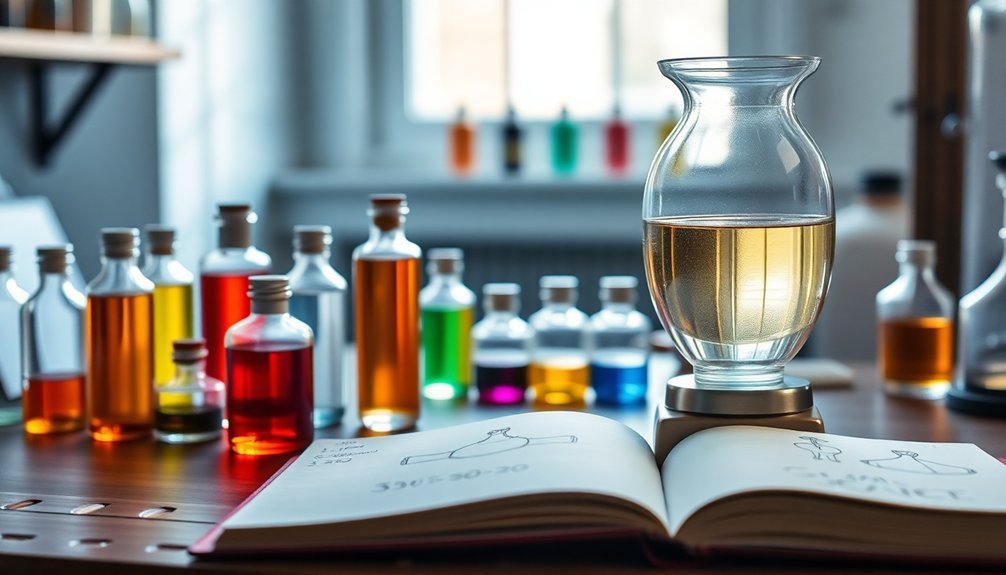
While many aspects of perfumery involve artistic intuition, the 30-50-20 fragrance ratio provides a scientific foundation for creating balanced scents.
You'll find that this precise formula accounts for how different fragrance components evaporate over time, ensuring a consistent scent experience.
The ratio dictates that 30% should be top notes, which you'll smell immediately but only last one to two hours.
Middle notes make up 50% of the blend, emerging as the top notes fade and persisting for two to four hours.
The remaining 20% consists of base notes, which ground the fragrance and can last up to two days.
Understanding Base Notes: The 30% Foundation
When crafting a fragrance, you'll find that base notes form the critical 30% foundation that anchors your entire composition.
These heavier molecules, including classics like Cedarwood, Frankincense, and Vanilla, create a rich underpinning that allows your scent to linger on the skin for up to two days.
You'll want to blend these base notes carefully to support the lighter elements of your fragrance while ensuring a balanced, long-lasting presence that keeps your creation intact throughout its wear time.
Long-Lasting Scent Anchors
Base notes form the critical foundation of any lasting fragrance, serving as powerful anchors that make up 20-30% of your perfume blend. You'll find these heavy molecules working hard to guarantee fragrance stability, preventing your scent from dissipating too quickly. These deep, rich components enhance longevity, letting your signature scent linger for up to two days.
| Base Note | Characteristics | Duration |
|---|---|---|
| Cedarwood | Woody, Warm | 24-48 hrs |
| Frankincense | Spicy, Exotic | 24-36 hrs |
| Vanilla | Sweet, Rich | 30-48 hrs |
| Musk | Earthy, Deep | 36-48 hrs |
| Patchouli | Oriental, Heavy | 24-36 hrs |
Rich Foundation Blending Rules
Creating a solid fragrance requires mastering the 30% foundation rule of base notes. When you're blending essential oils, these deep, lasting components serve as the anchor that holds your entire fragrance blend together.
Base notes work harmoniously with other layers to create a sophisticated scent that evolves beautifully over time.
To master the art of base note blending, follow these fundamental rules:
- Always maintain the 30% proportion of base notes to guarantee proper longevity
- Select heavier essential oils like Cedarwood, Frankincense, or Vanilla as your foundation
- Focus on creating synergy between base notes and other layers for a balanced composition
- Test the lasting power of your blend to confirm the base notes provide adequate depth
Understanding these principles helps you create memorable fragrances that maintain their appeal long after application.
Heart Notes: The 50% Character Builder
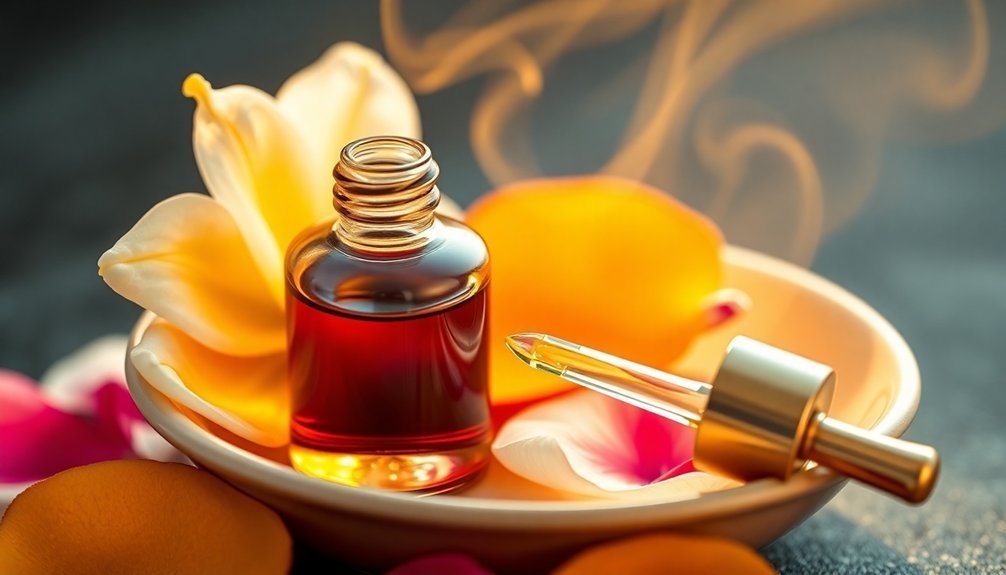
At the heart of every memorable fragrance lies its middle notes, which constitute 50% of the blend and serve as the scent's defining character.
When you're crafting your fragrance blend, you'll find that heart notes emerge after the initial impression fades, lasting two to four hours on the skin.
You'll want to carefully select heart notes like jasmine, rose, lavender, or clary sage to create the perfect balance in your essential oils mixture.
These notes aren't just fillers – they're vital bridges that connect your top and base notes while enhancing the fragrance's longevity.
As you develop your perfuming skills, you'll discover that mastering heart notes is non-negotiable.
They're the backbone of your creation, ensuring your scent evolves beautifully and leaves a lasting impression on those who experience it.
Top Notes: The 20% First Impression
While heart notes form the core of your fragrance, the initial moments of a scent encounter rest entirely on your top notes. These high-quality essential oils make up 20% of your blend and create that vital first impression that either draws people in or pushes them away.
You'll find these fresh, volatile scents evaporating within the first one to two hours of application.
When working with top notes, remember these key principles:
- Choose light, crisp scents like bergamot or sweet orange to create an inviting opening
- Guarantee your top notes seamlessly shift into the heart notes
- Balance the intensity – they should captivate without overwhelming
- Consider incorporating herbal elements like basil for added complexity
Your top notes set the stage for the entire fragrance journey, so selecting and blending them thoughtfully is fundamental for creating a harmonious composition.
Balancing Scent Families Within the Ratio
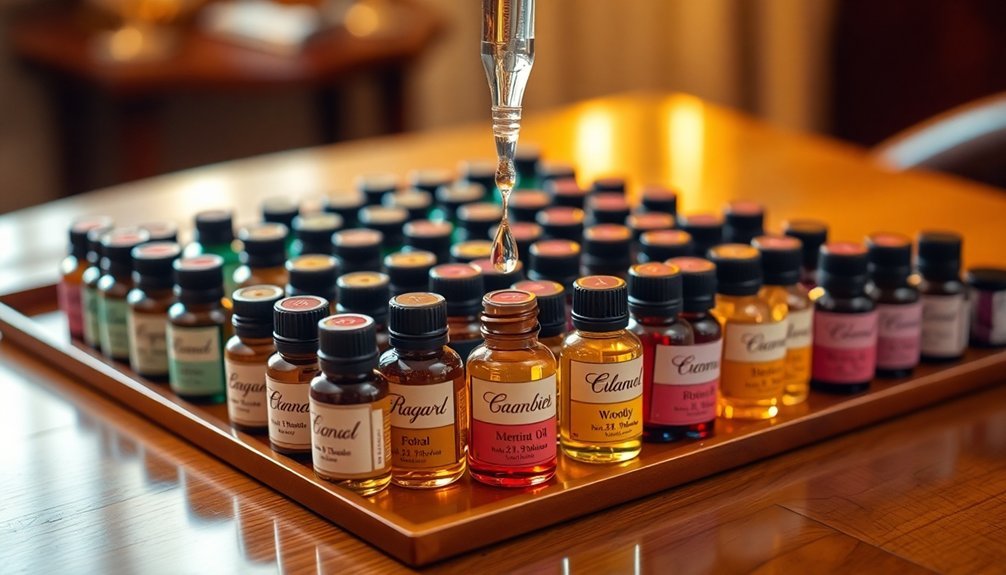
Beyond mastering the 30-50-20 ratio, successful perfumers must carefully balance different scent families within each layer of their compositions.
You'll want to select complementary scents within your top notes that create an inviting first impression while adhering to the 30% allocation.
For your middle notes, which make up half of your fragrance, you'll need to choose harmonious scent families that bridge the gap between the initial burst and the foundation.
When selecting your base notes, which comprise 20% of the blend, you'll need rich, lasting scents that ground your composition.
The key is ensuring each scent family you choose works within its designated percentage while maintaining a smooth progression between layers.
This careful orchestration creates a fragrance that evolves naturally from its bright opening to its deep, lingering finish.
Professional Techniques for Measuring and Mixing
You'll need precise measurement tools, including a 0.001-gram scale and disposable pipettes, to achieve consistent results when creating your fragrance blends.
Professional perfumers rely on sample bottles and scent strips to test their formulations before committing to larger quantities, saving both time and valuable raw materials.
Following the 30-50-20 ratio rule becomes manageable when you're equipped with the right tools and testing methods, allowing you to perfect your scent combinations through systematic experimentation.
Precise Measurements Matter Most
When creating professional fragrances, precise measurements serve as the foundation for success.
You'll need to master the art of exact proportions to guarantee your essential oil blends consistently meet the 30-50-20 rule. Using specialized scales that measure to 0.001 grams, you'll create perfectly balanced compositions that blend well every time.
- Use disposable plastic pipettes for transferring tiny amounts of fragrance oils, allowing you to make precise adjustments without waste.
- Test your blends on paper blotters to evaluate scent intensity and balance.
- Document every measurement meticulously, including ratios and ingredient amounts.
- Follow the golden ratio: 30% top notes, 50% middle notes, and 20% base notes.
Tools For Perfect Blending
Professional perfumery requires five essential tools to achieve perfect blending precision.
You'll need accurate scales that measure to 0.001 grams, guaranteeing your fragrances follow the 30-50-20 rule consistently.
Disposable plastic pipettes help you transfer essential oils and compounds with precision, allowing you to adjust ratios as needed.
To evaluate your blends effectively, you'll want paper blotters or scent strips that let you test combinations before finalizing your formula.
Don't forget sample bottles – they're vital for testing your mixtures without wasting expensive packaging.
Finally, you'll need a reliable labeling system to document each blend's development. This guarantees you can recreate successful formulas and track your progress.
These measuring tools work together to help you create consistently excellent fragrances every time.
Ratio Testing Best Practices
A successful fragrance blend starts with mastering precise ratio measurements and systematic testing procedures.
You'll need accurate measurements down to 0.001 grams to guarantee your 30-50-20 ratio remains consistent. When testing blends, use fragrance strips to evaluate how your creation develops over time.
- Start by weighing each component precisely, following the 30% top notes, 50% middle notes, and 20% base notes distribution.
- Apply your blend to multiple testing strips to assess the scent at different stages.
- Let your creation rest for at least 48 hours before making final judgments.
- Document each blend carefully, including exact measurements and your observations.
Remember to maintain detailed records of successful formulations, noting any adjustments you make along the way.
This systematic approach will help you refine your craft and create more sophisticated fragrances.
Common Pitfalls When Working With Fragrance Ratios
Creating balanced fragrances requires careful attention to ratios, yet many perfumers stumble into common traps that compromise their final products.
You'll risk developing imbalanced fragrances if you ignore the vital 30-50-20 rule, which guarantees proper distribution of top, middle, and base notes. When you don't respect this balance, your scents can become either overwhelming or too subtle.
Watch out for inadequate measurement precision, as eyeballing proportions or using improper scales leads to inconsistent results.
You'll also want to avoid overloading your blend with base notes, which can overshadow delicate top notes and create an unnecessarily heavy fragrance.
Remember to let your blends rest and develop – rushing this process prevents the full expression of scent characteristics.
Adapting the Rule for Different Perfume Types

While the 30-50-20 rule serves as a fundamental guideline for perfume creation, you'll need to adjust these proportions based on your fragrance type and intended effect. The key is understanding how different ratios can enhance specific fragrance families.
- For fresh, citrusy scents, increase top notes to 40% and reduce middle notes to 40%, keeping base notes at 20% to maintain vibrancy.
- When creating oriental or woody perfumes, boost base notes to 30% and reduce top notes to 20%, allowing middle notes to remain at 50%.
- For niche and gourmand fragrances, maintain the classic 30-50-20 rule to showcase complex middle notes.
- Light floral compositions benefit from a 40-40-20 distribution, emphasizing the initial burst while preserving the delicate heart notes.
These adjustments help you craft perfumes that truly capture your intended character and lasting power.
Frequently Asked Questions
What Is the 20/50/30 Rule for Perfume?
You'll want to blend your perfume using 30% top notes for initial impact, 50% middle notes for the heart, and 20% base notes for lasting depth. This creates a balanced, professional fragrance.
What Is the Ratio for Making Your Own Perfume?
When you're making your own perfume, follow the 30-50-20 ratio: use 30% top notes for initial scent, 50% middle notes for the heart, and 20% base notes for the lasting foundation.
What Is the 30 50 20 Rule for Essential Oils?
When blending essential oils, you'll want to use 30% top notes for initial scent, 50% middle notes for the heart, and 20% base notes for lasting depth in your fragrance mixture.
What Is the Strongest Concentration of Perfume?
You'll find that "parfum" or "extrait" is the strongest perfume concentration, containing 20-30% fragrance oils. It's the most potent and long-lasting option you can choose for your fragrance needs.
In Summary
You'll find the 30-50-20 rule serves as your essential guide to perfume creation, but don't feel constrained by it. Think of it as a starting point that you can adjust based on your creative vision. Whether you're crafting a light eau de toilette or a rich parfum, this ratio provides the structural foundation you need while leaving room for artistic interpretation and experimentation.
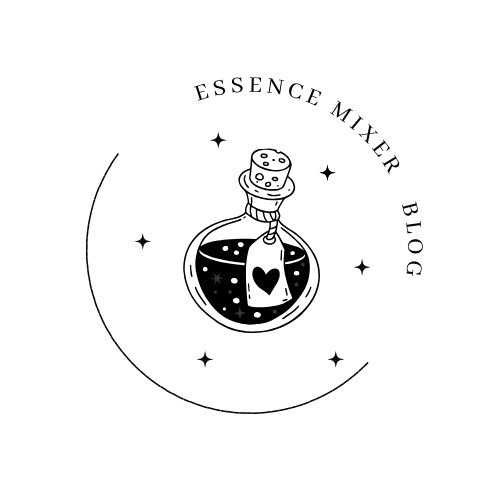
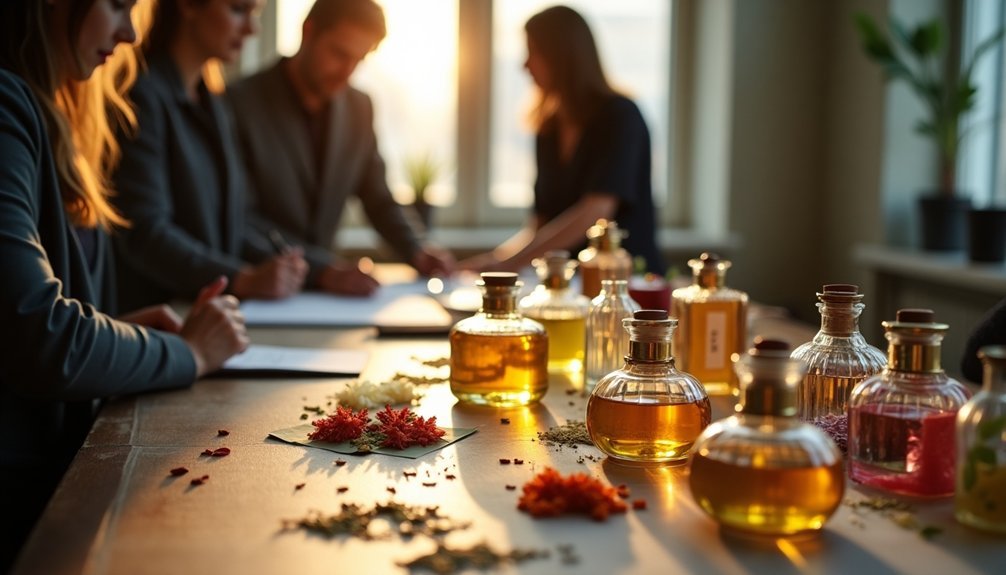
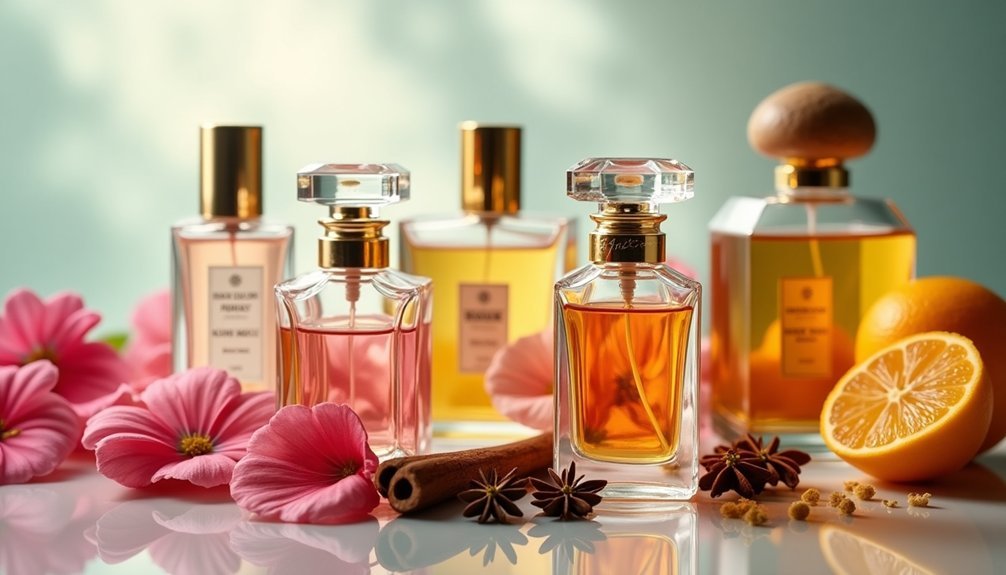
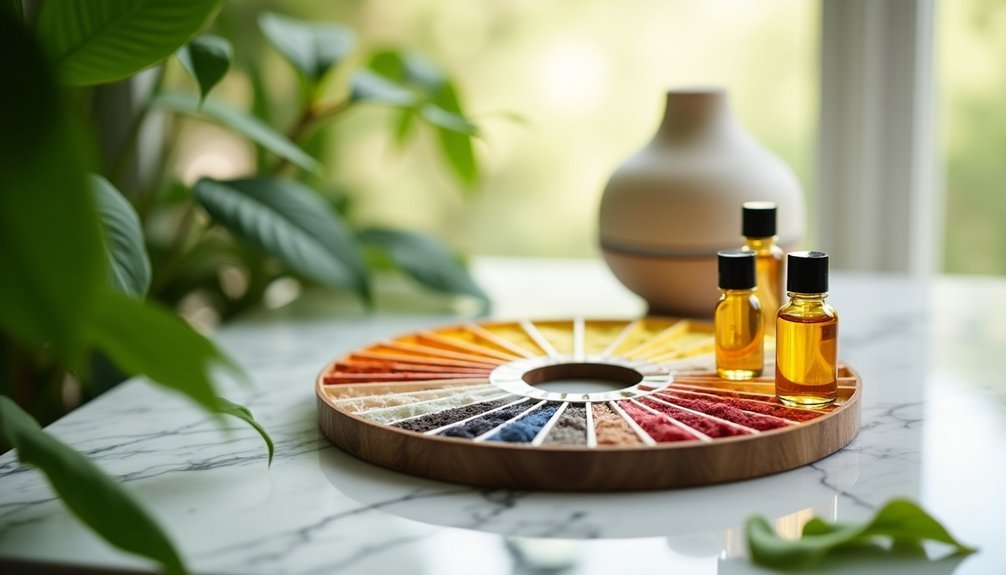
Leave a Reply